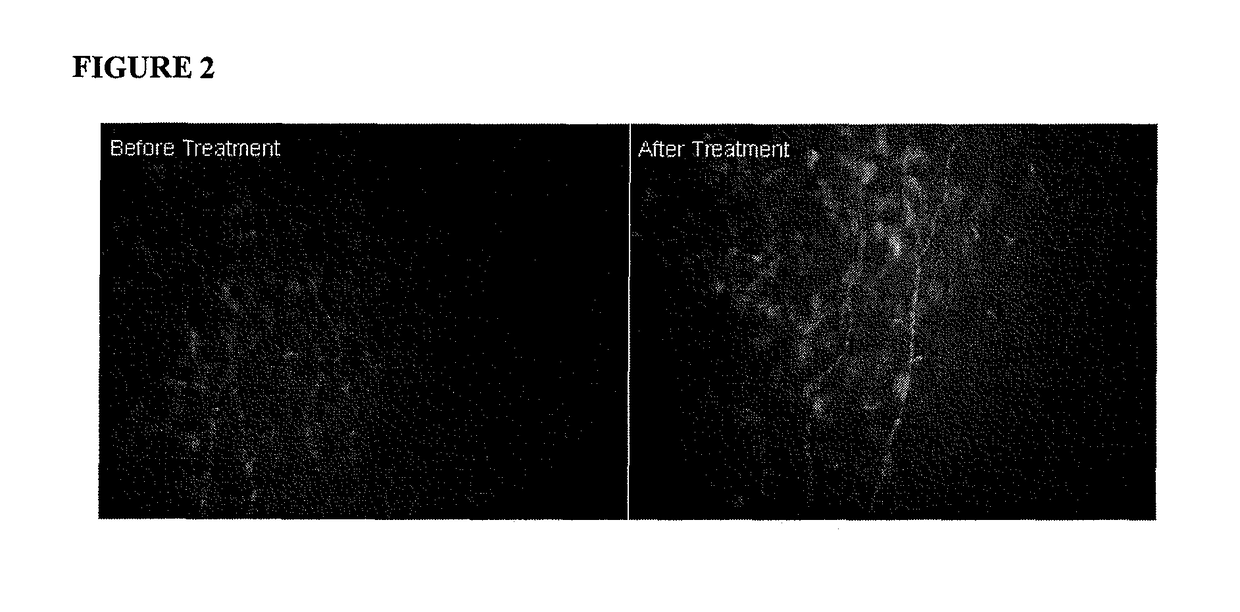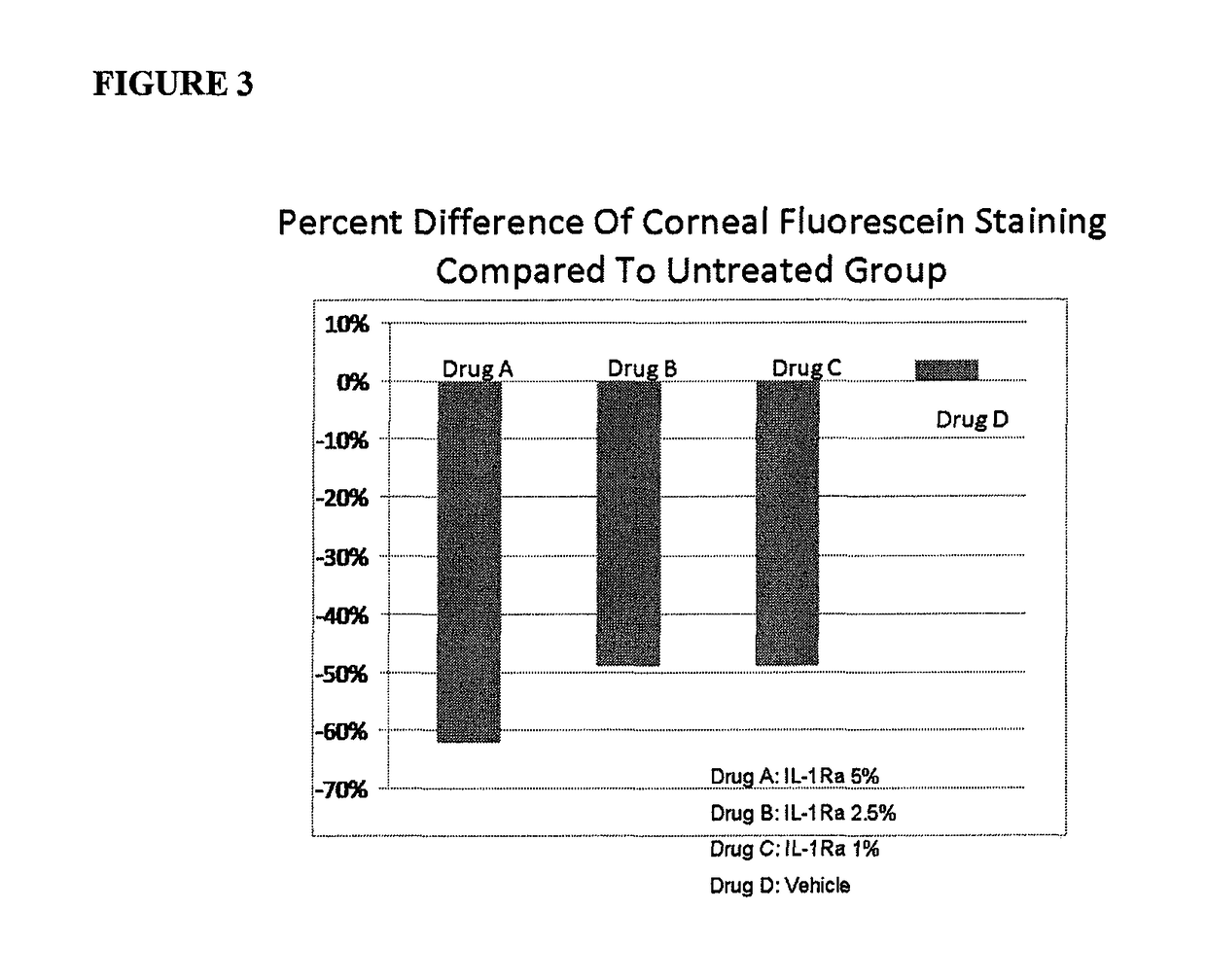Methods for reducing corneal nerves damage, corneal lymphangiogenesis or immunity to corneal antigens in dry-eye associated ocular surface diseases by IL-1Ra
a technology of corneal nerves and immune cells, applied in the field of ophthalmology, can solve the problems of not being able to fully understand the cause and not the symptoms of chronic ocular surface disease, and the development of treatments that address the cause rather than the symptoms is difficult, if not impossible, and achieves the effects of reducing corneal nerve damage, and enhancing corneal nerve regeneration
- Summary
- Abstract
- Description
- Claims
- Application Information
AI Technical Summary
Benefits of technology
Problems solved by technology
Method used
Image
Examples
example 1
IL-1 Blockade on Central Nerve Regeneration in Epithelial Disease
[0138]It was observed that subjects with the most severe clinical signs of dry eye reported feeling surprising improvement after administration of IL-1 blockade. Upon further investigation, patients with severe dry eye were found to also suffer after administration of IL-1 blockade corneal nerve damage or even loss of nerve function. To better elucidate the mechanism of this unexpected improvement following treatment, the contribution of nerve damage and function to the normal and pathological processes of tear production and dry eye was investigated.
[0139]To examine the role of IL-1 blockade in corneal nerve homeostasis, regeneration of the corneal subbasal nerve plexus and terminal epithelial branches after epithelial debridement was measured. Mice were anesthetized, and a 2-mm circular corneal epithelial defect was made in one eye of each anesthetized mouse using a scalpel blade. One group of mice (n=5) was treated ...
example 2
IL-1 Blockade on Dry-Eye Induced Lymphangiogenesis
[0142]Corneal angiogenesis is involved in the pathogenesis of adaptive immunity to corneal antigens and in inducing ocular surface disease. Lymphatic vessels are crucial for migration of resident antigen presenting cells to the draining lymph nodes and induction of adaptive immunity, but there is no information about the role of lymphangiogenesis in dry-eye associated ocular surface disease. In a mouse model of dry eye, it was determined whether IL-1 blockade can reduce dry-eye induced lymphangiogenesis. Dry eye was induced in female C57BL / 6 mice (n=10) by exposure to the controlled environment chamber and to systemic scopolamine. After 2 days, one group of mice (n=5) received topical IL-1Ra 2.5% mixed with carboxymethylcellulose 1% three times a day, and the second group received only the vehicle (carboxymethylcellulose 1%). After 5 days of treatment, animals were euthanized, and corneas were removed and fixed in 4% Para formaldehyd...
example 3
tion of Topical IL-1Ra
[0144]With respect to effects of IL-1 blockade on dry eye disease, different concentrations (1%, 2.5%, and 5%) of topical IL-1Ra mixed with carboxymethylcellulose 1% were tested in a mouse model of dry eye. Dry eye was induced in female C57BL / 6 mice (n=20) by exposure to the controlled environment chamber and to systemic scopolamine. After 2 days, mice were divided in 5 groups. The first, second, and third groups of mice (4 mice in each group) received topical IL-1Ra 5%, 2.5%, and 1% respectively, mixed with carboxymethylcellulose 1% in frequency of 3 times a day; the fourth group (n=4) received vehicle (carboxymethylcellulose 1%) in frequency of 3 times a day; and the fifth group (n=4) left untreated. After 5 days of treatment, corneal fluorescein staining was performed by applying 0.5 μL of 1% fluorescein by micropipette into the inferior conjunctival sac of the mouse eye. The cornea was examined with a slit lamp biomicroscope in cobalt blue light 3 minutes a...
PUM
| Property | Measurement | Unit |
|---|---|---|
| concentration | aaaaa | aaaaa |
| concentration | aaaaa | aaaaa |
| diameter | aaaaa | aaaaa |
Abstract
Description
Claims
Application Information
 Login to View More
Login to View More - Generate Ideas
- Intellectual Property
- Life Sciences
- Materials
- Tech Scout
- Unparalleled Data Quality
- Higher Quality Content
- 60% Fewer Hallucinations
Browse by: Latest US Patents, China's latest patents, Technical Efficacy Thesaurus, Application Domain, Technology Topic, Popular Technical Reports.
© 2025 PatSnap. All rights reserved.Legal|Privacy policy|Modern Slavery Act Transparency Statement|Sitemap|About US| Contact US: help@patsnap.com



